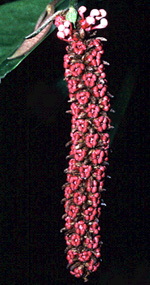 |
This primitive family is small but widespread, chiefly in the subtropics of the world and especially in East Asia. It is represented in Australia by three endemic genera each with a single species, all found in the rain forests of north-east Queensland.
Characteristic features of the family Hamamelidaceae in Australia include: - trees with alternate, simple leaves, with stellate hairs at least on some surfaces
- flowers unisexual, in short or elongate spikes, with 3 to 5 small sepals, and 5 free petals
- stamens 5 (sometimes with staminodes present as well); ovary superior or inferior, with two short, free styles
- fruit a woody capsule, splitting into two valves
Description
Evergreen trees, rarely shrubs. Internal secretions not obvious. Plants glabrous, or with stellate, non-glandular, unicellular hairs or peltate scales. Leaves alternate and spiral, or distichous, petiolate. Stipules distinct and free from the petiole, scale-like, membranous or bristle-like, falling off early. Lamina simple, symmetric, lanceolate, ovate, elliptic or oblong; base cuneate or attenuate; margins entire, ±flat; venation pinnate, with the midrib conspicuous, and the tertiary venation not reticulate; surfaces not punctate; herbaceous. All the flowers bisexual, or with male and female flowers on the same or on different plants. Inflorescences terminal, consisting of spikes. Bracts present. Pollination by insects or wind. Flowers sessile. Floral disc absent; nectaries absent or present on the stamens. Perianth regular, of 2 dissimilar whorls. Calyx segments free or fused, with 3 or 5 sepals or lobes, imbricate in bud; calyx cup-shaped or bell-shaped, herbaceous. Corolla segments free, with 5 petals, alternating with the sepals or calyx lobes, imbricate or valvate in bud, yellow or green, without contrasting markings, membranous; claws absent; lobes ±entire. Fertile stamens 5, opposite to the sepals or calyx lobes, free of the corolla, free of the ovary and style, distinct from each other, all ±equal. Staminodes present or absent. Anthers basifixed, not versatile, opening sideways by longitudinal slits or by valves, 2-celled; appendages apical. Ovary superior and sessile or part-inferior. Carpels 2 (–3), fused; ovary with 2 locules. Style terminal, branching from the base, or absent and the stigma ±sessile. Ovules 1 or 3 per locule, stalked; placentation axile. Fruit a dry, dehiscent loculicidal capsule; the perianth on the maturing fruit deciduous or dry and persistent. Disseminule micro-surface ±smooth, brown or black, dull. Seeds 1, 2 or 6 per fruit. Aril absent. Cotyledons 2. Embryo straight.
(Note: this description has been generated from the coded data compiled for the key. Any errors in the key data will be reflected in the descriptions.)
A treatment of the family Hamamelidaceae has been published in:
Flora of Australia 3: 1-4.
Australian genera of Hamamelidaceae (as recognised for the Flora of Australia)
Neostrearia
Noahdendron
Ostrearia

|
  |

Neostrearia fleckeri (flowers)
Photo: G.Sankowski © Zodiac Publications

Noahdendron nicholasii (flowers)
Photo: G.Sankowski © Zodiac Publications

Noahdendron nicholasii (flowers)
Photo: G.Sankowski © Zodiac Publications

Noahdendron nicholasii (fruit)
Photo: G.Sankowski © Zodiac Publications

|
 |
|